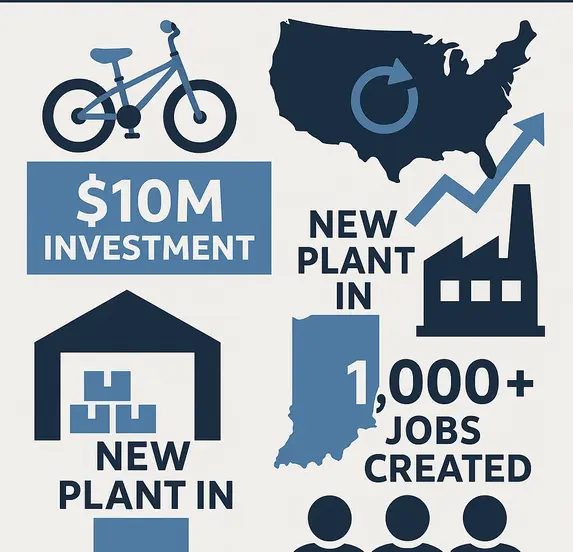Reshoring in Action: How Guardian Bikes Rebuilt U.S. Production
In a quiet corner of Seymour, Indiana, a quiet revolution is underway. Since 2022, Guardian Bikes has been manufacturing 12,000 high-end children’s bicycles each week from a sprawling 540,000-square-foot factory. It’s not just a comeback story—it’s a living case study of what U.S. manufacturing reshoring in 2025 could look like.
For decades, globalization drove production offshore, where cheaper labor and relaxed regulations gave foreign factories a clear edge. Now, companies like Guardian are challenging that narrative, leveraging automation, reshaped supply chains, and local labor pools to prove that domestic manufacturing isn’t dead—it’s just evolving.
The Path from China to Indiana: Why Guardian Bikes Came Home
Like many American manufacturers, Guardian Bikes initially relied on Chinese OEMs to produce their bicycles. This allowed them to maintain competitive pricing and scale quickly. But as costs in China rose and supply chain vulnerabilities became more apparent—especially during the pandemic—the company made a bold move: bring production back to the U.S.
Quality Control and Inventory Stability
By reshoring operations, Guardian gained tighter control over:
- Production quality
- Lead times
- Inventory flexibility
It also reduced dependence on international shipping—an increasingly unpredictable variable in global trade.
Automation: The Great Equalizer in Domestic Production
Guardian Bikes did not attempt to replicate traditional labor-intensive factory models. Instead, they invested in cutting-edge automation to reduce labor costs while increasing efficiency and precision.
What This Looks Like on the Factory Floor
- A bike is welded in just three minutes
- A finished bike rolls off the line every 30 seconds
- 250 workers, many from nearby laid-off auto plants, power this system
These workers aren’t just assembling—they’re operating, monitoring, and maintaining high-tech machinery. Guardian’s plant exemplifies how modern reshoring efforts must be automation-first to remain competitive.
The Bigger Picture: Why Reshoring Is So Hard
Guardian’s success is real—but it’s also rare. U.S. manufacturing employment has dropped from nearly 20 million in the 1970s to just 12.7 million today, and most of those jobs don’t resemble the factory work of the past.
Challenges Facing Reshoring Nationwide
- Many suppliers have disappeared: Guardian struggled to source basic bike components because domestic manufacturers for chains, gears, and other parts no longer exist.
- Labor costs remain high: Even with automation, labor represents a significant cost differential versus factories in China or Mexico.
- Environmental regulations increase costs: Unlike countries with lax enforcement, U.S. firms must invest in compliance and sustainability.
These obstacles mean that reshoring efforts must be strategic and highly automated—not just patriotic.
Can Tariffs Really Bring Jobs Back?
Guardian Bikes benefitted from tariffs on imported bikes and parts, which helped level the cost playing field. But this is a double-edged sword.
The Trade-Offs of Tariffs
- Pros:
- Encourage local production
- Reduce reliance on global supply chains
- Cons:
- Can raise prices for consumers
- May provoke retaliatory trade policies
- Increase input costs for some industries
Tariffs alone will not rebuild American manufacturing. Without complementary policies—such as training, infrastructure, and supplier development—they risk becoming blunt instruments with unintended consequences.
Why Automation Is Not the Enemy of Workers
Some economists argue that automation, not trade, is the main culprit behind job losses in manufacturing. While true in some sectors, Guardian’s model proves a hybrid approach is possible.
Reskilling America’s Workforce
Guardian hired workers who were previously laid off from auto plants in the region—people who already had mechanical skills and industrial experience. This created a labor force capable of operating advanced manufacturing systems.
However, not all regions have a ready pool of such skilled workers. Without national investment in technical training, the reshoring movement will struggle to scale.
Guardian’s Roadmap: 70% Domestic by 2025, 100% by 2026
Guardian isn’t done yet. The company is aggressively working toward:
- 70% of all parts produced domestically by 2025
- 100% U.S.-made bikes by 2026
This is more than a slogan—it’s an operational commitment. And it’s creating ripple effects: new supplier relationships, local material sourcing, and long-term job opportunities in secondary industries.
Looking to Hire Fast?
Hiring managers can now post jobs for free on WhatJobs
and connect with millions of jobseekers.
The Manufacturing Renaissance: Real or Rhetoric?
The broader U.S. economy continues to shift toward services and tech, and economists remain divided on whether a true manufacturing rebound is achievable.
What the Numbers Say
- Over 400,000 U.S. manufacturing jobs remain unfilled
- Many former factory workers now earn higher wages in service roles
- The environmental and compliance burden adds significant overhead
But Guardian Bikes offers a template for success in this new reality: high-tech, high-quality, and locally grounded. It’s not about going backward—it’s about building forward with precision, sustainability, and purpose.
FAQ: U.S. Manufacturing Reshoring 2025
What does U.S. manufacturing reshoring 2025 mean?
U.S. manufacturing reshoring 2025 refers to the trend of companies bringing production back to the U.S. from overseas, using automation and domestic suppliers to rebuild American industry.
Why is Guardian Bikes important for U.S. manufacturing reshoring 2025?
Guardian Bikes is a leading example of U.S. manufacturing reshoring 2025, showing that automation, skilled labor, and smart policy can make domestic production viable again.
What role do tariffs play in U.S. manufacturing reshoring 2025?
Tariffs support U.S. manufacturing reshoring 2025 by discouraging imports and making domestic goods more competitive, but they must be part of a broader policy strategy.




